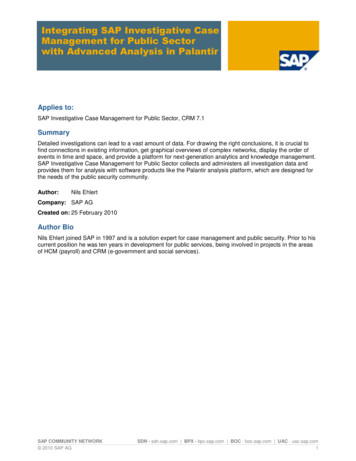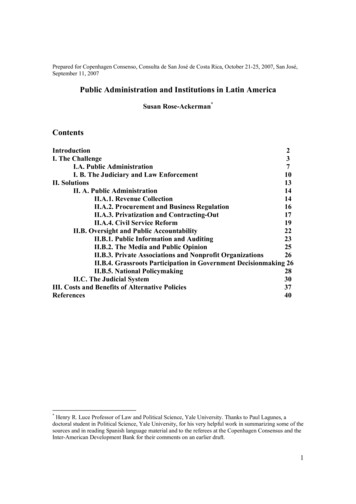
Transcription
Partnerships for Reform through Investigative Science and MathematicsANCHIALINEPONDSConceptsStudents will focus onan endemic animal thatlives in anchialineponds, the ‘opae’ula.They will observe anddescribe the body,structure and function,and behavior of thisanimal throughdrawings anddiscussion.HCPS III BenchmarksSC.K.1.1SC.K.1.2SC.K.1.3Duration1 hourSource MaterialPRISMMicro-lobster homepageAnchialine pondsdetective storyVocabularyEndemicFilter feedHabitatBody parts:AntennaeEyesHeadMouth partsSwimming legsTailWalking legsAn Introduction to ‘opae ‘ulaSummaryIn this lesson, students learn the major body parts of ‘opae ‘ula(Halocaridina rubra) by observing a live specimen in the classroom.From their observation, students discuss in groups and learn thefunctions of each body part of the shrimp.Objectives Students will construct habitat jars for ‘opae ‘ula.Students will identify and discover the functions for themajor body parts (structures) of ‘opae ‘ula.Students will observe ‘opae ‘ula behavior.Materials (per pair of students)1 large jarFive live ‘opae ‘ula (sold at local pet stores).1 magnifying glass or one digital microscope for the entire class1 cup of sand1 or 2 rocks covered in algae (you can find these in the intertidalzone)For the entire class:1 enlarged figure of ‘opae ‘ula with body parts labeled (see below).1 piece of blank paper or science journal for each student.Making ConnectionsWe see shrimp almost every day. They are on our dinner tables, inour refrigerators, and on the food shelves at the grocery store. Theyare being sold in the seafood markets, farmer’s markets andsupermarkets. We eat shrimp as food and use them as fish bait tocatch more food. Shrimp are used in various recipes and asingredients for many types of processed food. Shrimp are embeddedto our everyday lives.Teacher Prep for ActivityPurchase shrimp in advance at the local pet stores (see Backgroundsection on how to take care of them shrimp). Make copies ofenlarged ‘opae ‘ula figure and purchase (or borrow) magnifyingglasses. Set up an assembly line with the materials (sand, beach rockor dead coral, food and water) ready in boxes on a table before thelesson.Background‘Opae ‘ula, a.k.a. ‘opae, or the Hawaiian anchialine pond shrimp isthe most common endemic (unique to one place) shrimp found in theIntroduction to ‘opae’ula1
Partnerships for Reform through Investigative Science and Mathematicsanchialine ponds of Hawai‘i. In Hawaiian,‘opae means shrimp and ‘ula is red. It is believed thatthe deep ocean current transported the larvae of ‘opae ‘ula from one island to the next, and theycolonized the anchialine ponds by traveling through small underground fissures (tiny openings inporous lava substrates). Although an ‘opae ‘ula is smaller than a dime, it can tolerate a widerange of environmental conditions such as fluctuating water salinity and temperatures. ‘Opae‘ula filter feeds on algae, plankton, bacteria, and diatoms in the water. ‘Opae ‘ula is easy tomaintain in captivity and is a popular household pet.Native Hawaiians used ‘opae ‘ula as fish food in their fishponds. It is believed that ‘opae‘ula used to be so abundant in the anchialine ponds that, from a distance, the water in the poolsappeared to be red. Today, ‘opae ‘ula live in much lower densities (quantity), and are copingwith habitat loss due to human activities.To create an ‘opae ‘ula habitat, you will need a wide-mouth gallon jar, beach rocks, sandand water. Some people collect water from anchialine ponds, but ‘opae ‘ula can survive in cleandistilled water as well. You should place a baby food jar in the gallon jar to hold a piece of deadcoral and some black sand. The ‘opae ‘ula jar should be placed in an area that gets 3-4 hours ofsunlight everyday for algae to grow. ‘Opae ‘ula feeds on algae and the oxygen that algae create.You may feed ‘opae ‘ula supplemental food such as blue-green algae (spirulina flakes fromhealth food or pet stores), but this is not necessary as long as there is enough algae growing inthe jar. A one-gallon jar should sustain five ‘opae ‘ula. After the lesson, ‘opae ‘ula jar can bekept in the classroom as class pets.ProcedureGo over new vocabulary (save the body part vocabulary for later) and write newvocabulary on the ongoing Anchialine Ponds Vocabulary chart paper.2. Be sure the assembly line for the habitat jars is set-up and ready (see teacher prep).3. Begin the lesson by introducing vocabulary and the shrimp body parts using theprovided figure of ‘opae ‘ula (see attached page).4. Introduce "habitat" and ask students what animals need in a habitat to live (water, food,shelter).5. Put the students into partner pairs. One partner gathers habitat materials from assemblyline table, then passes the jar to the other partner after putting together the habitat. Theother partner receives 4 to 5 ‘opae ‘ula from the teacher.6. For each pair, they should have a jar of ‘opae ‘ula, magnifying glasses, and a figure of‘opae ‘ula (print out your own or use the attached figure).7. Based on observations, each student draws a picture of ‘opae ‘ula on a piece of blankpaper or in their science journal. Their drawings should be detailed and big (fill up thewhole page). The vocabulary words on the different body parts can be reviewed whilethe students are drawing. See attached suggestion page on how to draw a shrimp.(Optional activity: The teacher can set up 2-3 stations with digital microscopes, dependingon the resources and supervision available. Call one pair at a time to each station forobserving ‘opae ‘ula under the microscope. It is necessary to place a shrimp in a small,shallow dish with a small amount of water, in order to focus the microscope. Thisactivity can be done while students are making their drawings.)8. After the students finish drawing, have the partners discuss the following questions withone another (you may come up with more questions): Does an ‘opae ‘ula have a head, legs, a tail, and a body? Where are these parts?1.Introduction to ‘opae’ula2
Partnerships for Reform through Investigative Science and MathematicsWhat does an ‘opae ‘ula use for swimming? How does an ‘opae ‘ula swim up and down in the jar? How does an ‘opae ‘ula eat? What do you think it is eating? Where do ‘opae ‘ula like to hide?9. Encourage students to describe their answers using their drawing or the provided figure.Allow ample time for discussion and presentation of the results.10. The lesson can be followed by reading “The Adventures of Ebi the ‘opae ‘ula”. Add atleast ten (10) minutes to the lesson duration.Note: This lesson can be broken down into two sessions. Before the actual lesson, the teachermay have the students make pencil drawings of the shrimp by looking at pictures of ‘opae ‘ula.On the lesson day, students will color in the body parts with red/orange crayon on their pencilsketch as they locate them on the live specimen. AssessmentsEach student has a drawing of ‘opae ‘ula.Each pair discusses their findings.ResourcesMicro-lobster homepage ialine ponds detective story (www.hear.org/hoike/pdfs/coastal unit3 act1.pdf)Extension ActivitiesTake the class on a fieldtrip to conduct a census of an anchialine pond site in the North Konaarea at the end of the unit as a culminating activity. During the field trip, students will draw theanchialine ponds and what surrounds them (i.e. vegetation). Students will point out what animalsand how many they see in the ponds. Use the Anchialine Pond Field Trip Worksheet in theSupplemental Materials folder.Literature ConnectionThe Adventures of Ebi the ‘opae ‘ula by Bobby Hsu and Jackie GaudiosoThis book takes students on an adventure with Ebi, a young ‘opae’ula and his life in ananchialine pond. The story provides examples of biological concepts of habitat, predation,foraging, anatomy, and ecological communities while using a social framework that stresses theimportance of family, friendship, protection, and sharing within the storyline.Introduction to ‘opae’ula3
Partnerships for Reform through Investigative Science and MathematicsSuggestion on how to draw a shrimp.Body (abdominalsegments)EyeTail (uropods)Head(carapace)Swimming legsAntennae“Claw”Walking legsIntroduction to ‘opae’ula4Mouth parts
‘Opae ‘ulaPartnerships for Reform through Investigative Science and MathematicsIntroduction to ‘opae’ula5
Partnerships for Reform through Investigative Science and MathematicsANCHIALINE POND FIELD TRIP! WorksheetNameDate:Where ?Draw the anchialine ponds you see!
Partnerships for Reform through Investigative Science and MathematicsWhat animals and plants do you see? How many?Plants#Howmany?Animals
other partner receives 4 to 5 'opae 'ula from the teacher. 6. For each pair, they should have a jar of 'opae 'ula, magnifying glasses, and a figure of 'opae 'ula (print out your own or use the attached figure). 7. Based on observations, each student draws a picture of 'opae 'ula on a piece of blank paper or in their science journal.











